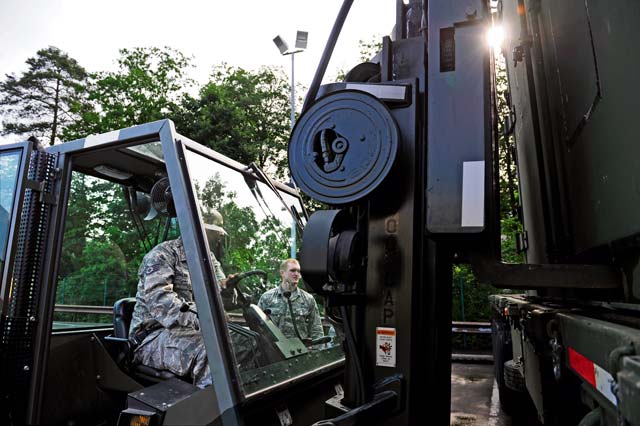
Ramstein units took a half-day break from normal forklift and other material handling equipment operations to focus on safety June 28.
“The overall purpose of this day is to refocus on safety and drive home accurate operational risk management,” said Master Sgt. Tariq Abdullah, 86th Vehicle Readiness Squadron vehicle operations superintendent. “From loading and unloading, to training the right way to be a spotter, we’re covering it all.”
The day started with a briefing on the purpose of the five-hour stand-down and rolled into MHE and forklift safety awareness.
“We have been fortunate to not have many MHE accidents here, but anything that keeps our Airmen safe in the long run is something worth doing,” Abdullah said. “Our stance is to accept no unnecessary risks and to eliminate complacency.”
During the day, there were two different stations, concentrating on four different aspects of MHE and forklift safety.
The first station focused on operator care, maintenance and inspection of the MHE. The inspection consisted of belt, oil, tire and hydraulic checks followed by 100 percent accountability of personal protective equipment, like gloves and safety glasses.
“Our goal is to reinforce the message of how important safety is to us,” Abdullah said. “We want every Airman, son, daughter, husband and wife, to be able to go home at the end of the day. If it takes a half-day of concentrating on nothing but safety to do that, then I am in.”
The other station showed proper loading and unloading of cargo, followed by spotter training, which is aiding a driver who has limited view of his surroundings.
“Spotter training is important because if you are driving a forklift and carrying something big, you won’t be able to see,” said Tech. Sgt. Patrick Tobin, 86th VRS NCO in charge of training and validation. “Knowing the correct hand signals when spotting can mean the difference between a perfect load and being permanently disabled or even a loss of life.”
But as much as safety is stressed, accidents still happen and can be fatal.
In the last two and a half years, USAFE-AFAFRICA bases have experienced one disability, 23 lost work days and approximately $325,000 in damage to MHE vehicles.
“I was stationed at a joint base while deployed once,” Abdullah said. “We preached how to stop when you can’t see your spotter. One guy was spotting another backing up an MRAP (mine resistant ambush protected vehicle) when the driver lost sight of his spotter. He didn’t stop and crushed his spotter.”
“We tell these stories not to scare everyone, but to make them understand why proper safety techniques are so important,” Tobin said. “Having these set standards helps avoids confusion.”
All MHE operators go through Occupational Safety and Health Administration’s training and recertification every three years. The recertification training is conducted by the unit’s vehicle control officer and follows with a written test.
“It’s important to stop every once in a while and review what we do every day,” said Tech. Sgt. Jesus Pimentel, 86th Maintenance Squadron NCOIC of aerospace ground equipment production support. “Most of us do this day in and day out without thinking about it. But, it’s important to stop and see what bad habits we have developed and reset ourselves to ensure we are doing it right and safe.”


